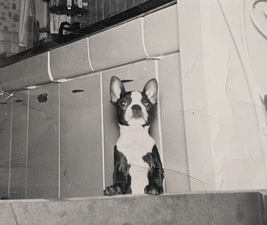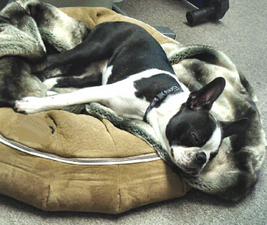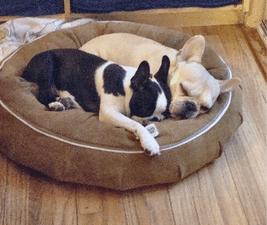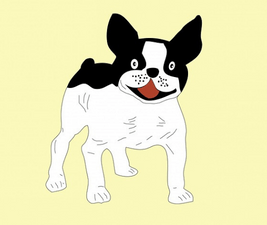Since when are dogs expected to allow anyone to do anything to/with them? Take away their food bowl. Let anyone pet them. Allow other dogs to get within sniffing distance. How about we let dogs say no?
Our first dog was a Boston Terrier named “Spunky.” He was a fantastic dog, a phenomenal best friend for two little girls. He was well-mannered, gentle, and lived up to his name. When we would try to do something to him, like pet him when he was eating, our mother would say “How would you like it if someone did that to you?” So we wouldn’t. On his behalf, our mother said “No!”
Boundaries are good
Dogs are amazing, smart, adaptable critters. They also do better when new stuff is introduced slowly, other beings respect their boundaries, and they’re allowed to be themselves.
Most dogs also give clear indicators when they’re uncomfortable or frightened. There are usually many clues before a dog will bite or snap. If a dog is licking its lip, turning its head away, or you can see the whites of their eyes, they’re sending a message that they’re not comfortable. It does the dog a disservice to allow whatever’s happening to continue.
As dog trainers, we tell all our students that distance is your friend. If your dog isn’t comfortable with something, back off until they relax. If the event that made them uncomfortable is one they need to get used to, do it gradually. One sure sign that a dog is doing okay is if they’ll take treats from you. When you reach their comfort boundary, they may stop taking those morsels.
It happened in the shop all the time. Dogs would come in thinking they were someplace where bad or scary things happen. We gave them the time, and distance, they needed to get used to the idea of “trying on” harnesses. Some dogs never got there. That’s okay – we just guided their owners for the fittings.
We told you not to do that
We’re reminded of a series of incidents with our bookstore cat, many years ago. A good friend of ours brought each of her four children to the shop. And, when each one was about four or five years old, they would be petting Merlyn, the cat. He was a typical cat – he loved pets until he didn’t, and then grabbed your hand with his teeth to let you know he was done.
We knew Merlyn’s signs of “enough!” very well. And we told the children “That’s enough, now. Merlyn’s tired of being petted.” And, in turn, Merlyn grabbed their hands. He never broke skin, but he did leave dents.
And each child went running over to their mother, crying “The cat bit me!” And each one heard “What did you do?” Obviously, if it hadn’t been a friend, we wouldn’t have let it happen. But we knew how our friend would react. It was important to her that her children learn to a) listen and b) respect animals.
Let dogs say no
Strangers don’t have to pet your dog. No matter how little, fuzzy, and cute your dog is. You and your family are the only ones your dog has to put up with. Tango, Fran’s 13-year-old Brussels Griffon, didn’t like much of anybody but Fran. It was important to us that he change, so we did it gradually. Everyone he met was given a handful of treats to toss on the floor near him. Then a little closer to them. Then, step-by-step, take the cookies from their hands. Over time, Tango grew a bunch of cookie-people friends. Now he’s the sweetest old guy. And anybody is allowed to pet him. But it worked because this dog was allowed to say “no!”
Enjoyed this post? Click here to sign up for the weekly newsletter and never miss another!












